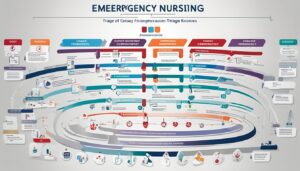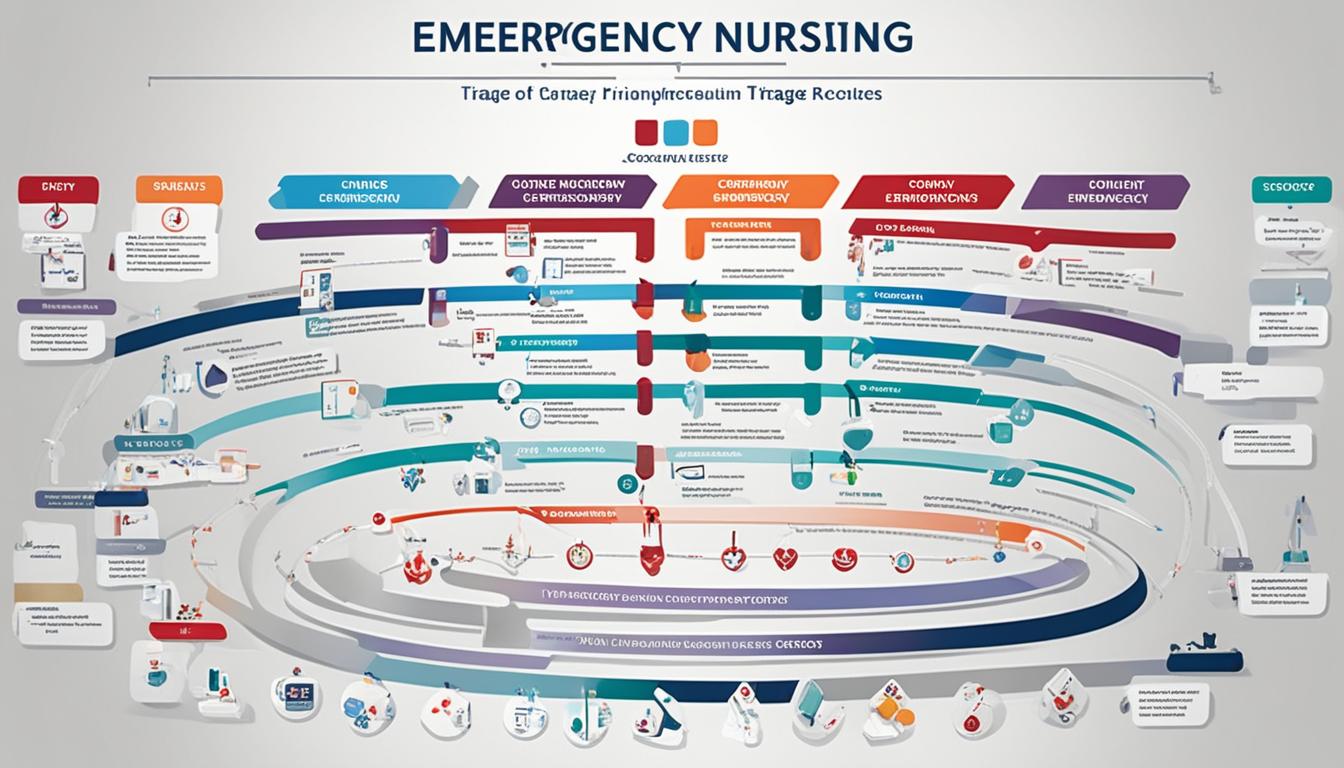Especially in the codes of emergency medicine, time is of essence and many actions can mean life and death. Triage checks that emergency nurses in the United States perform per year total 130 million they play an important role in health care. Speaking of what this guide describes, it is essential to note the significance of emergency nursing triage.
The information it recovered includes the topic, important points, methods, and how nurses can assess and sort patients in emergency departments. Though presented as a scholarly work, it enables readers to understand how the process of triage can be made better, and patients cared for, effectively.

Key Takeaways
- Emergency nurses perform more than 130 million triage assessments annually in the U. S,; hence, illustrating the significance of triage in healthcare delivery.
- Triage means verification and categorizing of patients by their severity of their state. This ensures that the most desperate cases get tenders as soon as possible.
- Responsible triage systems such as 5-Level Triage System and the Emergency Severity Index (ESI) answers well patient flow in the emergency departments.
- In particular, general assessment skills, particularly the speed of check and sorts, the knowledge of the basics and main indications of vital signs, and the understanding of methods of pain management are essential to emergency nurses.
- Hence, proper communication and record keeping assist in ensuring that care is efficient and continues during triage.
Understanding Triage in Emergency Nursing
To state the obvious, prioritization is critical in emergency healthcare. It guarantees that individuals with the serious problem get assistance without any delay. Well, what is triage and why is it such an important factor that cannot be done without in the emergency rooms?
What is Triage?
Triage comes from the French word trier, translated as sort: this is how the departments of emergency sort and treat their patients. The nurses also attend to all the patients and assess who amongst them is in dire need of assistance.
Importance of Triage in Emergency Situations
Systems include observation where they identify and focus on the symptoms and the different vital signs. Then, they assign the urgency level to the patient. This way, the most severe cases are attended to first, and the progression of the illness is halted or slowed down considerably.
The way the patients are sorted out the order in which they receive the basic treatment is very important in the ER. They help in dealing with the multiple cases that make up emergency rooms. Thus, triage effectively ensures that available, and limited factors such as human resource and beds, are utilized as desired.
Triage Systems and Levels
This means the patients with serious illnesses, diseases among them are treated fairly, quickly, and efficiently. It’s vital to understand in nursing what is triage helps to save people’s lives. Why triage is necessary in emergency departments is it maintains the flow of the emergency room efficiently. It plays a vital role in patient’s speedy progression through the particular system. This is why the whole emergency healthcare system in the country steps up its functionality.
5-Level Triage System
Thus, in emergency nursing, triage system is the thing that is most important. They ensure that a patient receives appropriate treatment as soon as possible. There are mainly two systems that organize the triage procedures, namely, the 5-level triage scale and the Emergency Severity Index (ESI).
The five categories of the 5 level triage system sort patients in groups according to the severity of their sickness and the need for attention. Nurses identify a patient and then they rate them at level one to five. The first one is the most important while the fifth one is the least important or rather less of a priority. This system enables the nurses to determine who is in more need of help and how to best manage resources in case of an emergency.
Emergency Severity Index (ESI)
Specifically, the Emergency Severity Index (ESI) to enable the female nurses to easily identify which patients require attention most in the emergency room. It assigns a number ranging from 1 to 5 to patients, where the scale is the most severe with 1. Thus, the ESI examines the severity of the patient’s condition, potential need for intervention, and time to receive it.
| Triage Level | Description | Anticipated Wait Time |
| 1 | Resuscitation | Immediate |
| 2 | Emergency | Within 10 minutes |
| 3 | Urgent | Within 30 minutes |
| 4 | Less Urgent | Within 60 minutes |
| 5 | Non-Urgent | Within 120 minutes |
Discussed 5-level triage scale and Emergency Severity Index (ESI) are critical in the framework of triage within emergency nursing. Doctors and nurses use and organize them to make decisions and prioritize care in stressful conditions such as the ER.

Rapid Assessment and Prioritization
Perishable information is important in emergency nursing, thus, fast assessment of these patients is apt. It is imperative that nurses review a patient’s condition, his or her vital signs, as well as symptoms at a fast pace. This enables them to group and attend to the patients according to the severity of their condition.
First of all, the nurses assess the status of the airway, breathing and circulation of the patient. Then, they get detail info such as chief complaint of the patient and his/her past health records. This assists them in determining whether the crisis is grave and what they specifically need to do to address the problem.
| Triage Level | Description | Intervention Time |
| 1 – Resuscitation | Immediate threat to life, limb, or function | Immediate |
| 2 – Emergency | Potential threat to life, limb, or function | Within 10 minutes |
| 3 – Urgent | Potentially serious condition that requires prompt attention | Within 30 minutes |
| 4 – Semi-urgent | Less urgent condition that requires attention | Within 60 minutes |
| 5 – Non-urgent | Condition that can wait for treatment | Within 120 minutes |
A standard tool such as the Emergency Severity Index (ESI) helps the nurses. It enables them to screen and roster the patients according to the disease status and the resulting requirements. Such a system ensures that critical conditions receive immediate attention and the other cases are addressed when they are due.

The prioritization process of patients in emergency nursing triage is not static in approach. Nurses are always conducting the assessment of patients and modifying their respective plans of care. These watch and think carefully are perhaps the most important aspects for a medical practitioner to help patients in the emergency room.
Emergency Nursing Triage: Key Considerations
To sum up, it can be stated that in emergency nursing, the issue of triage is of primary significance. Thus, it is warranted to pay attention to what is involved in the process of checking and sorting patients.
It is knowing about the pulse rate and blood pressure and such detailed things like precisely how a physical checkup is conducted.
These are some of the steps that assist the nurses in making good choices or a right decision and at the same time take good care of their patients.
Vital Signs and Physical Assessments
The first assessment process involves the check on the patience general status including the assessment of the pulse and respiration rates. This entails checking on their temperature, pulse rate, respiratory rate as well as blood pressure.
These signs provide to nurses the severity of the particular patient’s status and what type of treatment they require within a short span of time. In addition, a physical assessment is very important in triage.
This assists the nurses to understand the nature of the symptoms the patient is experiencing, the previous health status and any concealed issues. This info assist nurses to know what to do first.
The observation of the patient’s body by the nurses enables identification of such complications faster. This way, they are able to offer the requisite care to the right clients to start with.
Pain Management
There is nothing as critical as managing pain well within the triage area. People in the emergency room have various painful conditions due to accidents or existing diseases. Male nurses have to be conscious of how many pains they endure.
They employ specialized instruments to assess pain and ways to manage the same to enhance the patient’s comfort. FP to nurses entails concentrating on vital signs, physical exams, verifying the client’s pain and enabling her to make wise decisions as a result.
This they in turn could be able to give their best in offering the care that is required to the patients. It ensures that only the critically ill are attended to quickly and all the patients receive their services.

Communication and Documentation
As apparent in emergency nursing triage, it is crucial to be articulate and have the ability to put issues on paper. Nurses should also be able to obtain relevant information to relay patients’ needs effectively and also be team players. :this contributes to providing the best services to the patients.
Effective Communication Strategies
Speaking well is very important in emergency nursing triage. Nurses also need to be good listeners in order to hear what is required from the patients, families and the other physicians. This communication skills in emergency nursing triage assist the nurses to understand what is to be done and relay the information to the team.
I here note that it is also important to discuss in triage, though when doing so, any mechanical noise is eliminated. Appropriate communication in this case entails nurses requiring to provide relevant information such as how severe the condition of the patient is, what pains, and what needs to be done next.
This goal of documentation in ER triage process ensures that every individual involved in the patient’s care knows what is required of them. Of course good communication also entails the use of body language and making the caller or the person on the receiving end know that they are valued. Such things as to look in eyes, stand open, and even kindness contributes to the trust.
This assists patient and families to have a sense of safety and receiving care. It is easier when one learns how to effectively relate with people in emergency nursing triage. This results in improved patients’ care and the development of a robust team.
Triage Challenges and Ethical Dilemmas
As highlighted throughout the paper, challenges that surround the emergency nursing triage together with the ethical aspects of the ER triage process makes it difficult for nurses. It is a profession where they most often have to make decisions involving the rationing of resources. They have to act in patient’s interest and make the triage process more objective.
Thus, emergency nurses have to rapidly scan through all the patients and prioritize those who require the assistance of a nurse most and need it urgently. This is difficult especially when many patients develop the infection and yet the health facility has few devices. They must ensure that the most critically sick get the help they need immediately.
There are so many Ethical issues involved in the process of triage in the ER, and all of them are always very stressing. It implies that nurses they may be forced to decide who among them will be attended to first or how they can divide whatever is available. They create a greater impact in patients and it leaves the nurses to wonder on fairness in the society.
To address these challenges, the nurses need to have adequate knowledge of referral and have good communication skills besides possessing good ethics. It requires them to make some decisions quickly, and they have to remember that they are dealing with patient’s lives and health.

To deal with such scenarios, nurses must continue learning and training with other teams. As discussed, making decisions together, communication, and concentration on patient’s needs are the ways to meet the challenges in emergency nursing triage. They can also adhere to the most ethically responsible concerns when carrying out triage in emergency rooms.
Emergency nursing triage: Best Practices
Triage is in fact the cornerstone of any good emergency care. Emergency nurses have the crucial roles of assessing acutely ill patients and determining the priorities when allocating care. Ideally, workers must continue to educate themselves so as to perform in the capacities demanded from them.
Training nurses ensures that they update their strategies to working with patients. This enables them to make fast sound decision. Doctors can attend so many patients due to technology and assist the patients better.
These areas should include new triage methodology, communicating with patient, managing patient’s discomfort/pain and right and wrong options. It assists nurses and hospitals to become the best that they can be. Nurses should also collaborate with other teams, attend conferences and also involve themselves in learning.

This makes them prepared in the ever-demanding nature of emergency care. When the care following emergency nursing triage is optimized in line with these best practices, patients are safer, and care is improved. It is strategic to train your nurses well. It results in loving care or efficient care depending with the circumstances of a child’s situation.
Streamlining the Triage Process
Consequently, nurses attending to patients in emergency situations must be able to scan their clients’ needs very fast and sort them appropriately. Improving the situation is using standard triage rules and algorithms that improve the quality of identifying patients. One of the instruments that can be of value in this regard is the Emergency Severity Index (ESI).
Triage Protocols and Algorithms
The ESI system is useful for nurses as it enables them to determine the severity of the patient’s illness and the required treatment. It employs a clear plan that enables a patient’s condition to be easily assessed within the shortest time possible.
In this way, it becomes possible for nurses to be able to provide care at the appropriate level of intensity instantly. Some other systems include the Canadian Triage and Acuity scale (CTAS) and Manchester Triage System (MTS) that assist the nurses as well. Application of these tools makes triage excellent and assists patients to access the appropriate care as early as possible.
FAQ
1. Triage in emergency nursing: What is it?
While working in emergency nursing, the act of assessment and sorting patients involves assessment of the severity of a patient’s situation. This way, the researchers, whose situation is critical, receive assistance immediately.
2. What is the significance of triage during delivery of emergency services?
Triage is critical in emergencies because it ensures that resources are well utilized. It assists us to deliver care with respect to the severity level of a patient. This means the most severely-ill gain care in the shortest time possible.
3. That is, what kinds of the triage, and what levels are used in the Emergency Nursing?
Systems exist in emergency nursing such as the 5-level of triage and ESI (Emergency Severity Index). The current caring structure is referred to as the 5-level system refers to arranging patients into five categories on the basis of severity of their illness. The ESI is an operating instrument that the nurses employ to sort matters and/or assist patients in the quickest manner.
4. What happens to differential triage in emergency nurses working conditions?
Nurses go over short observations, practical objectives, assessment of what ails patients, and current status that include identifiers, vital signs, and pain. With this info they are able to identify the people that need their assistance the most and attend to them first.
5. Triage process is another critical aspect of the emergency nurses and the following factors should be considered.
It’s a role where nurses pay much attention to assessing a patient’s vital signs and other comprehensive assessments during the triage process. They also make sure they manage the patient’s pain.
6. Where and how can communication and documentation be used in the emergency nursing triage?
Mentioned above are some of the roles of Triage; Good communication and detailed notes are very essential in triage. The message received indicates that nurses require getting the right information, disseminating the patient’s requirements effectively, and collaborate with other team members. The notes are useful when making decisions and ensure that care is not reduced on the patient.
7. What are the difficulties and some of the issues of clinical and ethical nature that emergency nurses encounter during the triage procedure?
Challenges relating to nurses include; availability of resources, quick decision making and others that are not mentioned. They also make such delicate decisions about whom to assist first. They have to maintain the fairness of the categorization and patients’ interests at the forefront.







